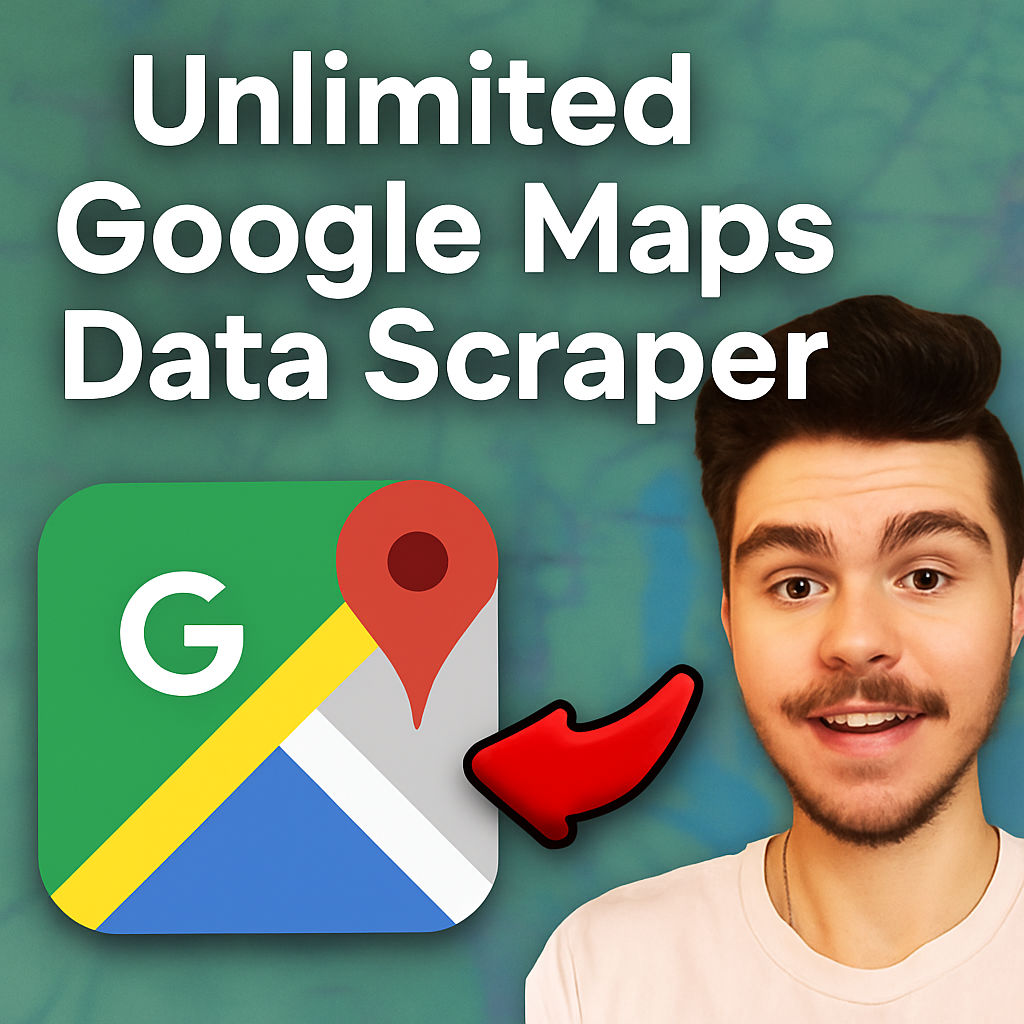If you’re searching for the most effective way to access unlimited Google Maps data for free, you’re in the right place. Scraping valuable information from Google Maps can empower your business efforts—whether you’re building prospect lists, researching local competitors, or nurturing leads. This article breaks down how to use a powerful (and totally free) online tool to scrape Google Maps data without restrictions or hidden costs. All steps, benefits, and limitations are covered, so you can confidently tap into location-based business data at scale.
Based on the original video:
Why Unlimited Google Maps Data Matters for Businesses
Access to unlimited Google Maps data opens opportunities for modern businesses, marketers, lead generators, and SEOs. By collecting comprehensive business listings, you can:
- Build hyper-targeted outreach lists for cold calling, email, or direct mail
- Analyze competitors in specific cities, neighborhoods, or niches
- Find local partners or vendors efficiently
- Audit businesses’ digital presence—like missing websites or low review counts
- Research geographic trends and target high-potential areas
Doing this manually would take hours, but the right automation tool brings this data to your fingertips in a fraction of the time.
Introducing ScrapeTable: The Free Google Maps Data Scraper
The transcript details a free web app, “ScrapeTable,” purpose-built for unlimited Google Maps data extraction. No payment, no signup, and no restrictions on how often you can use it. Anyone needing business insights, phone numbers, or addresses for their marketing, research, or outreach—this tool stands out.
Here are the core benefits of ScrapeTable:
- No cost, no account required—totally free, unlimited access
- Flexible search by location and keyword—uncover business data by city, type, or niche
- Rapid export—download your results as Excel, CSV, or JSON in seconds
- Detailed output—extract names, addresses, phone numbers, ratings, reviews, and more
This approach is an authentic, people-centric route to gathering the information you need.
Step-by-Step Guide: How to Scrape Unlimited Google Maps Data
Let’s walk through the full process using ScrapeTable, so you can see how to replicate and customize this method for your own needs.
1. Accessing the Free Scraper Tool
First, head to the tool—linked in the video’s description and available on the scrapetable.hrzn labs website. The homepage includes a quick walkthrough and frequently asked questions. You can either follow along with documentation or the accompanying video tutorial for live steps.
2. Selecting Locations (URLs)
There are two main methods to choose the locations you want to scrape data from:
- Maps Button: Use the in-app map interface to browse any location. Search for a city, area, or drag the map, then save the current map URL for later scraping.
- Add Links Manually: Go to Google Maps, conduct any search (like “hotels Miami”), copy the URL, and paste it directly into ScrapeTable. You can mix and match both methods.
Each project can include up to five unique URLs at once, enabling searches across several regions or city clusters simultaneously.
Tip: To use the mapping feature, make sure your browser’s location permissions are enabled. On Chrome, if results don’t appear, check for a location access prompt near the address bar.
3. Inputting Your Keywords
After you’ve entered locations, type in the specific business keyword you wish to target. Examples include:
- Hotels
- Fast food
- Plumbing
- Dealerships
Simply select the term that fits your campaign or research goal.

4. Running the Data Extraction
With both locations and a keyword in place, click the “search” button. The tool will process your request—scraping results from each URL and returning matched business listings. This typically completes in 15–60 seconds, depending on the number of URLs and keyword complexity.
5. Downloading Your Results
Once your search is complete, you’ll see the number of businesses scraped (e.g., 248 businesses for “hotels,” 510 for “fast food”). You can export the results instantly in three formats:
- Excel
- CSV
- JSON
Open the downloaded file and you’ll find neatly organized business data, including:
- Name
- Full address
- Phone number
- Business ID and place ID
- Website (if available)
- Review count and average rating
- Type of business and keywords
- Latitude and longitude
- City and state
- Business status (verified, open/closed), and more
6. Navigating and Using the Business Data
This multisource business information can bolster your outreach, research, or B2B marketing by letting you filter by website presence, verification status, star rating, or geographic zone.

Want to narrow things further? For example, if you’re interested only in businesses in Miami with ratings of 4 stars or higher and with a website, you can easily filter for these attributes in Excel or Google Sheets—making follow-up seamless and targeted.
Key Takeaways and Best Practices for Scraping Google Maps Data
- Scalability: Each scrape can cover up to five map searches at once—speeding up your data harvest significantly.
- No Email Addresses: Google Maps does not display or allow scraping of business email addresses. To find these, you must visit a business’s website directly using the exported links.
- Export in Multiple Formats: Depending on your workflow, you can export to Excel for manual work, CSV for importing into CRMs, or JSON for technical projects.
- Helpful for Outreach & Prospecting: Phone numbers, addresses, and websites enable robust local marketing and cold outreach campaigns.
- Potential for Analysis: Use the data to analyze gaps in a region (e.g., identify businesses lacking a website or those with low ratings for reputation management prospecting).
If you’re embedding video or further illustrating your process for your audience or teammates, you may want to incorporate video content directly into your workflow. For step-by-step help, explore this comprehensive guide to embedding videos on your website or blog.
Examples of Effective Google Maps Data Scraping
The transcript’s walkthrough demonstrates varied scrape scenarios across industries and geographies:
- Hotels in Florida: Fetched 248 business listings from Miami, Hollywood, and West Palm Beach, complete with contact data and ratings.
- Fast Food: Pulled 510 entries, including major chains and independent restaurants, full with crucial business info.
- Plumbing Services: Gathered 803 service businesses for competitive research or outreach.
- Dealerships: Extracted 737 car dealerships, showcasing differentiation between franchise and independent used car sellers.
Having access to rich attributes like geo-coordinates, business types, and operational hours accelerates the process of building or analyzing local business lists for any vertical.
Pro Tips for Maximizing Your Google Maps Data Harvest
- Combine multiple keywords and area URLs: Mix different terms and cities to uncover every possible lead.
- Check browser permissions: Always ensure location access is allowed to use interactive maps smoothly.
- Create outreach-ready spreadsheets: Use filters to isolate prospects, such as unverified businesses or those lacking a web presence.
- Donate if you find the tool invaluable: While 100% free, supporting development keeps innovative tools accessible for all.

Automation, AI, and the Future of Data Scraping
The driving force behind this tool’s development is the modern intersection of AI and automation. Today’s data-driven workflows rely on having fast, broad, and reliable access to information. ScrapeTable was originally envisioned as a SaaS product but was ultimately released as a free public utility to foster wider accessibility.
If you’re inspired by the story and wish to explore tailored automation solutions—for example, building custom bots or AI-driven lead systems—the original creator invites beta users for future projects. AI-powered phone bots, as mentioned in the transcript, represent the next frontier in automating calls, bookings, and business communications. Consider reaching out if such innovations would benefit your business.
Common Questions About Google Maps Data Scraping
How much Google Maps data can I extract for free?
With the described tool, you can scrape data from up to five Google Maps search URLs at once, as often as you like—without any paywalls or usage caps.
What business information can I access using this method?
You can export business names, addresses, phone numbers, websites, geo-coordinates, ratings, reviews, types, city and state details, operational hours, and more. Email addresses are not included and must be found via each business’s website.
Can I download my results for use in Excel or my CRM?
Yes, results are available for download as Excel, CSV, or JSON files. You can import or analyze these in Excel, Sheets, or most CRM tools.
Why can’t I get business emails directly from Google Maps?
Google Maps does not publicly display or allow scraping of email addresses for privacy reasons. Emails must be gathered by visiting individual business websites found in your export.
Does this tool work across different countries and keywords?
Absolutely. As long as a business is listed on Google Maps and you include the relevant keyword and location URL, the scraper will fetch available data worldwide for any niche.









